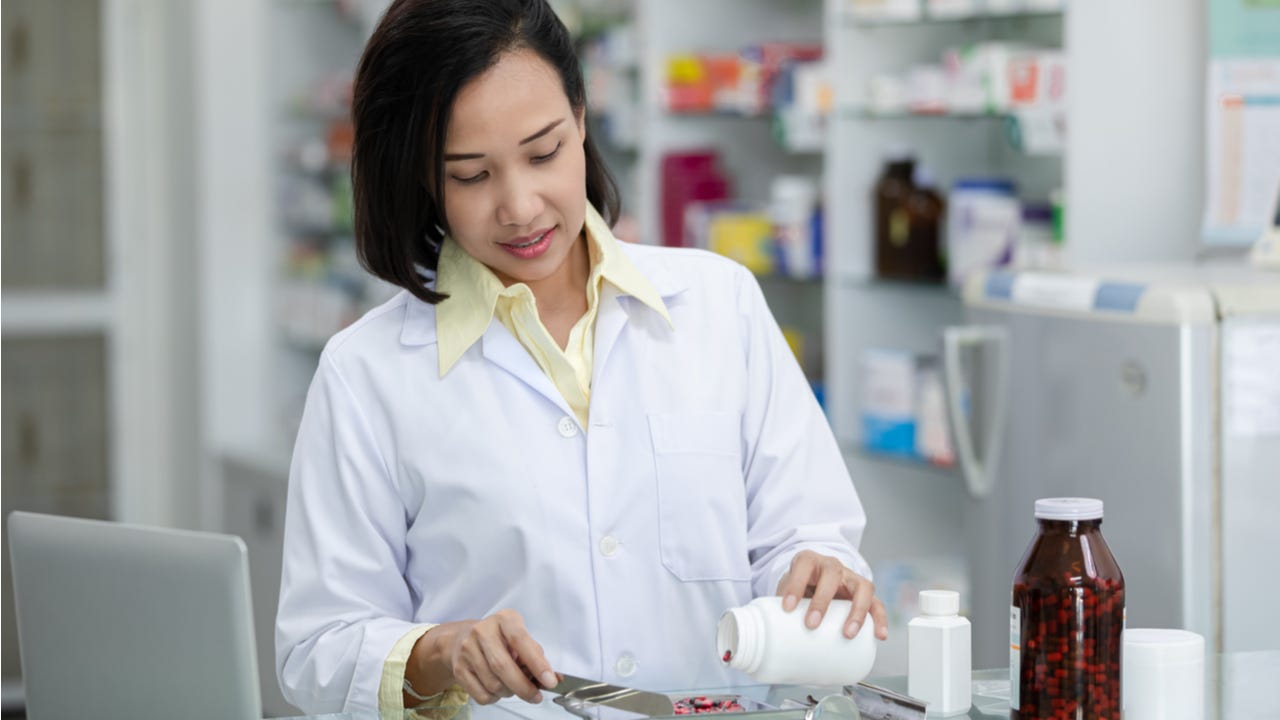What is the average pharmacy school debt?

The Bankrate promise
At Bankrate we strive to help you make smarter financial decisions. While we adhere to strict , this post may contain references to products from our partners. Here's an explanation for .
Key takeaways
- The average student loan debt for pharmacists was $167,711 as of 2023, with private pharmacy schools having a higher average debt compared to public schools.
- Interest rates on pharmacy school student loans currently range from 4.13% to 16.70%, and interest accrues during schooling.
- The standard repayment term for federal student loans is 10 years, but it may take longer for pharmacists to pay off their debt due to the high average amount.
- Options for reducing pharmacy school debt include loan forgiveness programs, repayment assistance and refinancing, but it's important to carefully consider which path is best for your individual situation.
Attending pharmacy school can lead to a lucrative career filled with many job options. But the cost of pharmacy school is no joke. According to a 2023 report from the American Association of Colleges of Pharmacy (AACP), student loans for pharmacists amount to an average of $167,711.
If you’re considering becoming a pharmacist and wondering if the debt is worth it, the good news is that the degree will open up many career paths, including being a clinical, community or institutional pharmacist. You’re also likely to be paid quite well, with the average pharmacist salary well over six figures.
Still, earning the degree required to access these career options and the top salaries comes with a steep price tag. Here’s what you need to know about financing a pharmacy school education and your options for repayment.
What is the average pharmacy school debt?
In its survey of pharmacy school graduates, the AACP found that roughly 82.2 percent of PharmD degree holders had to borrow money to get through school. The latest data also shows that the average pharmacy school debt sits at $167,711.
It’s important to note, however, that private pharmacy colleges skew the average upward. While the average pharmacy school student loans for private institutions averaged $200,305 in 2023, students attending public colleges averaged $138,060.
What goes into pharmacy school debt?
Attending pharmacy means paying for more than just tuition. While specific fees vary, costs for pharmacy school generally include:
- Tuition: Tuition can vary substantially if you attend an in-state school versus an out-of-state school or a public school versus a private school. The tuition will be the most expensive component of your pharmacy school debt and will cover your classes and the cost of being a student at your school.
- Fees: Most colleges have fees included in their cost of attendance. These fees, such as a lab fee, transportation fee or student services fee, are different at each school.
- Books and supplies: Textbooks, computers and other class supplies can add up. However, you can cut down costs in this category by buying or renting used textbooks and looking for sales on your supplies.
- Living costs: No matter where you decide to go to school, you will need to pay for food and somewhere to live. You can choose to live on campus, off-campus or at home.
What are the average interest rates on pharmacy school student loans?
The interest rates on your pharmacy school debt can vary depending on the type of student loans you have and when you applied for them. While federal student loan interest rates are standardized — everyone who qualifies gets the same terms — rates are updated yearly and vary based on loan type.
If you borrow private student loans, your interest rate will depend on your chosen lender and your creditworthiness. As of February 2024, private student loan interest rates range from just about 4.13 percent to 16.70 percent. With private student loans, you can usually choose between fixed and variable rates. Variable rates typically start lower, though you risk your rate climbing over time.
One thing to note with student loans is that most accrue interest while you’re in school, even if you’re not making payments — the only exception being Direct Subsidized Loans, which are available only to undergraduate students with financial need.
Once you start making payments, any interest accrued will be capitalized and added to your principal balance.
| School Year | Direct Loans for Undergraduate Students | Direct Loans for Graduate and Professional Students | Direct PLUS Loans for Parents and Graduate and Professional Students |
|---|---|---|---|
| 2024-23 | 5.50%, 4.99% | 7.05%, 6.54% | 8.05%, 7.54% |
| 2021-22 | 3.73% | 5.28% | 6.28% |
| 2020-21 | 2.75% | 4.3% | 5.3% |
| 2019-20 | 4.53% | 6.08% | 7.08% |
| 2018-19 | 5.05% | 6.6% | 7.6% |
| 2017-18 | 4.45% | 6% | 7% |
| 2016-17 | 3.76% | 5.31% | 6.31% |
| 2015-16 | 4.29% | 5.84% | 6.84% |
How long does it take to repay pharmacy school student loans?
The standard repayment term for federal student loans is 10 years, and private student loan companies may offer repayment terms ranging from five to 20 years.
Since the average student loan debt for pharmacists is much higher than the average for all college graduates, you may need to opt for a repayment plan on the longer side to keep monthly payments low. If you have federal loans, you may be able to extend your schedule up to 30 years, depending on the program.
| Repayment Plan | Repayment Term |
|---|---|
| Consolidation Loan | Up to 30 years |
| Extended | 25 years |
| Pay as You Earn | 20 years |
| Revised Pay as You Earn | Up to 25 years |
| Income-Based | Up to 25 years |
| Income-Contingent | Up to 25 years |
If you have private student loans, your repayment term will be what you chose when you first applied. If you can’t afford that, though, you can refinance your student loans to get a longer term.
Ultimately, though, the amount of time it’ll take you to pay off your pharmacy school debt will depend on how much you owe and your salary during the first stage of your career.
Tips for reducing pharmacy school debt
There are plenty of opportunities to pay down your pharmacy school student loans, some of which involve assistance from an outside source. Here are some options to consider.
Pharmacist student loan forgiveness programs
If you have federal student loans, the U.S. Department of Education may offer forgiveness of your debt if you work full-time for a government agency or eligible not-for-profit organization and meet other eligibility criteria.
The Public Service Loan Forgiveness program requires you to make 120 qualifying monthly payments on an income-driven repayment plan. After you meet all the requirements — check the department’s website for the full details — your remaining balance will be forgiven.
You can also receive forgiveness if you’ve completed an income-driven repayment plan and still have a balance left over. Remember, though, that these plans extend your schedule by 20 or 25 years, which means you’ll be indebted for a long time until you qualify for relief.
Student loan repayment assistance programs
Only the Department of Education can offer pharmacist student loan forgiveness. But you may also qualify for student loan repayment assistance programs through a federal or state agency. In the medical field, many of these programs are limited to practicing physicians, nurses and workers in similar career paths.
For example, the National Institutes of Health and the Health Resources and Services Administration both offer programs with student loan repayment assistance. Speak with your school’s financial aid office to get an idea of all that’s available for pharmacy school graduates.
Student loan refinancing
Student loan refinancing may be an excellent alternative if you don’t qualify to get assistance with reducing your student loan debt.
With student loan refinancing, you’ll replace your existing loans with a new one through a private lender. Interest rates vary based on your creditworthiness, but depending on what you’re paying now, you may be able to get a lower interest rate and save money.
Student loan refinancing is also the only way to extend your repayment term on private student loans — or even shorten the schedule if you can afford it.
Remember that if you’re working toward student loan forgiveness or repayment assistance, or you want to take advantage of an income-driven repayment plan, refinancing may not be the best path for you. You’ll no longer qualify for those benefits once your federal loans become private loans.
The bottom line
So, is pharmacy school debt worth it in the long run? It can be a worthwhile investment with proper planning and financial management, but it won’t be the right move for every student.
That’s because, while attending pharmacy school can lead to a lucrative career, the cost of education is a significant factor to consider. The average pharmacy school debt is currently over $167,000, and it is essential to be aware of the potential financial burden before committing to this career path.
Still, there are options for reducing debt, such as student loan forgiveness programs and refinancing, that could help you reduce the overall cost of your education. And, ultimately, it is crucial to carefully weigh the costs and benefits and explore all available resources to make an informed decision.
Frequently asked questions
-
The average student loan debt for pharmacy school graduates is around $167,711 as of 2023, with private college graduates averaging $200,305 and public college graduates at $138,060.
-
The time it takes to pay off pharmacy school debt varies based on the amount owed and the repayment plan chosen. Standard federal student loan terms are 10 years, but repayment can be extended up to 30 years with certain plans. Private loans offer terms ranging from five to 20 years, and refinancing is an option if you need a longer term to manage payments. The actual payoff time will ultimately depend on your specific financial situation and repayment strategy.
-
Becoming a pharmacist can be financially rewarding, with a median salary of $132,750 as of 2022. The job market is expected to grow by three percent from 2022 to 2032, and offers both flexible hours and remote work opportunities. Salary growth is modest in this field, but with careful planning and debt management, the return on investment can be significant, especially if the career aligns with your goals and offers high earning potential.
Related Articles



Pharmacist loan forgiveness programs: What they are and how to qualify
